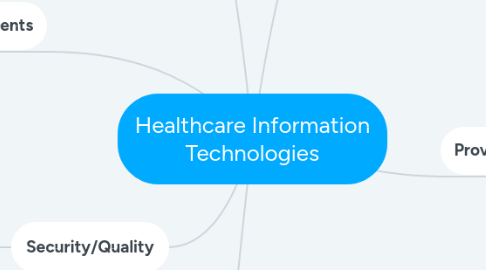
1. Medical Billing/Insurance
1.1. Information Technology allows medical billing and coding to be done electronically. This method is faster and more efficient when processing medical bills and insurance reimbursements.
1.2. Healthcare Integrity and Protection Data Bank (HIPDB)
1.2.1. Created as part of HIPAA to combat fraud and abuse in health insurance and health care delivery by alerting users to conduct a comprehensive review of a practitioner’s, provider’s, or supplier’s past actions.
2. Patients
2.1. Telehealth/Telemedicine
2.1.1. Cheaper healthcare option for non-emergent diagnosis/treatment
2.2. Personal health records (PHRs)
2.2.1. You can use a PHR to keep track of information from your doctor visits. PHR can also reflect your life outside the doctor’s office and your health priorities, such as tracking what you eat, how much you exercise, and your blood pressure.
3. Security/Quality
3.1. Certified in Healthcare Privacy and Security (CHPS)
3.1.1. CHPS professionals organize and manage privacy and security programs within organizations to protect patient information.
3.2. Agency for Healthcare Research and Quality (AHRQ)
3.2.1. DHHS agency that supports research designed to improve the outcomes and quality of health care, reduce its costs, address patient safety and medical errors, and broaden access to effective services.
3.3. Data Integrity
3.3.1. Audits
3.3.1.1. Data has integrity if it is accurate, complete, consistent, up-to-date, and the same no matter where the data is recorded.
4. Hospitals/Clinics
4.1. Health Information Exchange (HIE)
4.2. Telehealth/Telemedicine
4.2.1. Follow-up appointments through hospitals and clinics to service patients in rural areas, and to prevent overcrowding in the ER with non-emergent treatments/diagnosis (for those without insurance)
4.3. Self-serve Kiosks
4.3.1. Expedite registration
4.3.2. Process copay payments
4.4. Electronic health records (EHRs).
4.4.1. Sharing information interdepartmentally and with different providers such as specialists
5. Providers
5.1. mHealth
5.1.1. mHealth allows physicians to monitor patients remotely and document any orders related to patient care. Patients and hospital staff have access to these orders and treatment plans, making communication between staff/patients more accurate.
5.2. Telehealth/Telemedicine
5.2.1. Providing care to patients in rural areas
5.3. Electronic prescribing
5.3.1. E-prescribing allows your doctor to communicate directly with your pharmacy. This means you can go to the pharmacy to pick up medicine without having to bring the paper prescription.
5.4. Electronic health records (EHRs).
5.4.1. EHRs allow doctors to better keep track of your health information and may enable them to see it when you have a problem even if their office is closed.
